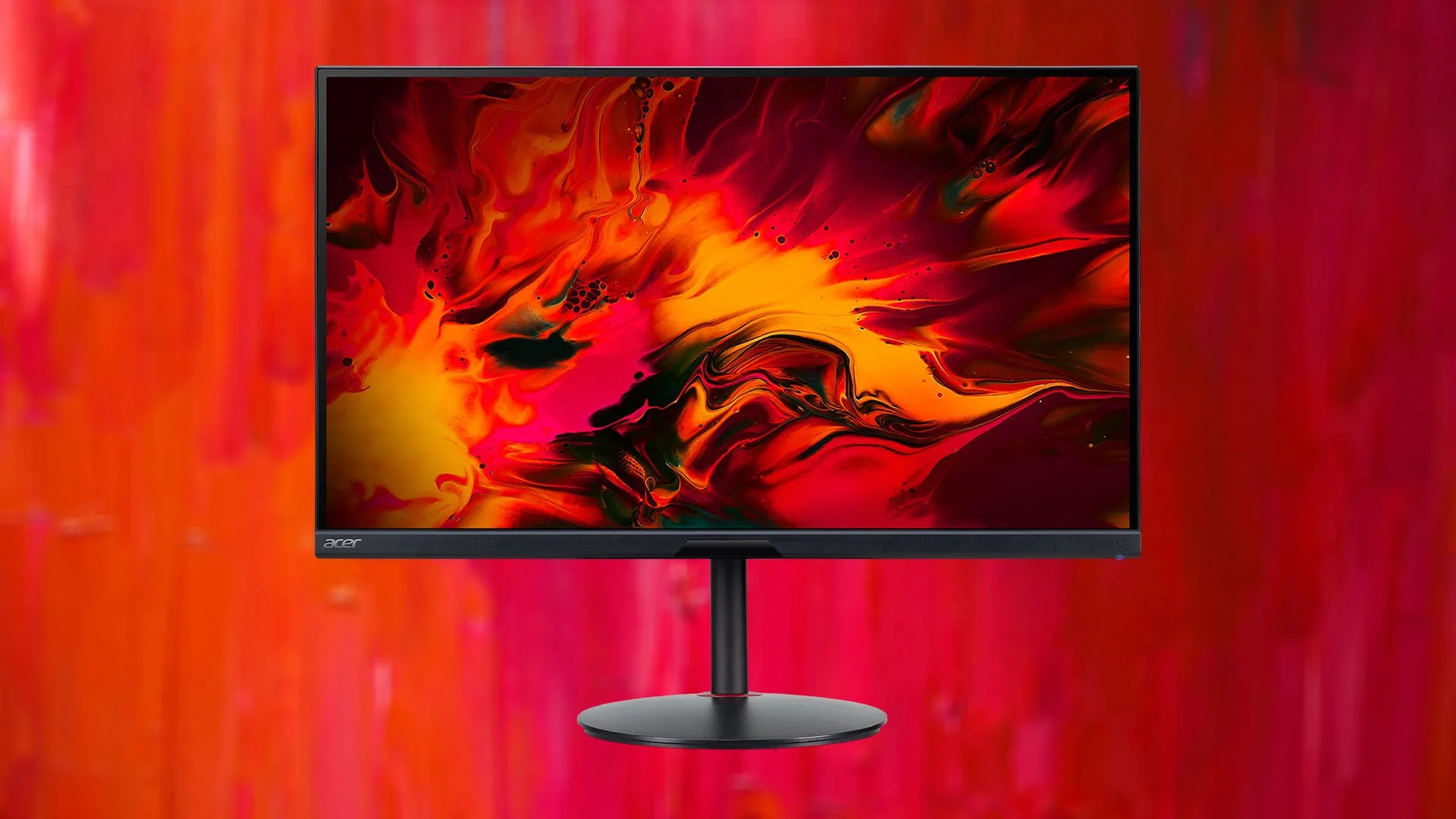When it comes to PC gaming, you’re going to want one of the best 4K gaming monitors, especially if you have a high-end graphics card like the Nvidia RTX 4090. Monitors like the RedMagic 4K Gaming Monitor, our number one pick, can display extremely detailed images, which is perfect when you want to see exactly what’s going on in your PC game. And even if that RedMagic panel isn’t exactly your dream monitor, there are a ton more gaming monitors out there.
TL;DR – These are the Best 4K Gaming Monitors:
RedMagic 4K Gaming MonitorLG UltraGear 27GN95B-BAcer Nitro XV282KGigabyte M28USony Inzone M9Asus ROG Strix XG32UQSamsung Odyssey Neo G7LG UltraGear 48GQ900Samsung Odyssey Neo G8Gigabyte M32UC
A 4K gaming monitor is the ultimate way to experience your favorite PC games, providing incredible sharpness with four times the resolution of a 1080p gaming monitor. More and more displays are featuring this high resolution, and to help narrow your search, we’ve tested and researched dozens of options, bringing you our top ten 4K gaming monitors – and click here to find them in the UK.
The Best 4K Gaming Monitors
1. RedMagic 4K Gaming Monitor
Best 4K Gaming Monitor
Screen size: 27″ | Aspect ratio: 16:9 | Resolution: 3,840 x 2,160 | Panel type: LCD IPS G-Sync, FreeSync Compatible | HDR compatibility: DisplayHDR 1000 | Brightness: 650cd/m2 | Refresh rate: 160Hz | Response time: 1ms | Inputs: 2 x HDMI 2.1, 1 x DisplayPort 1.4, 1 x USB-C (DisplayPort mode), 2 x USB-A, 1 x USB-B
The RedMagic 4K Gaming Monitor delivers a sharp, detailed picture with superb color accuracy on perfectly sized 27-inch screen. Its IPS panel with Mini-LEDs has an impressive 1,152 local dimming zones for a high contrast ratio ensuring punchy highlights and plenty of depth in dark, shadowy scenes, though there’s some slight blooming around bright objects. With HDR turned on, you’re viewing experience will be amplified further with vivider images that are on par with many OLED monitors.
RedMagic didn’t skimp on gaming features, including a DisplayPort 1.4 and USB-C with a DisplayPort mode, which both offer a 160Hz refresh rate in 4K. Two additional HDMI 2.1 ports max out at 120Hz and are perfect for hooking up a PS5 or Xbox Series X/S. Nvidia G-Sync and AMD FreeSync are compatible, so you’re graphics card and display play nicely for better motion handling at those high refresh rates.
2. LG UltraGear 27GN95B-B
Best Mid-Range 4K Gaming Monitor
Screen Size: 27” | Aspect Ratio: 16:9 | Resolution: 3,840 x 2,160 | Panel type: IPS FreeSync Premium Pro, G-Sync compatible | Brightness: 450 nits, 750 nits (peak) | Refresh rate: 144Hz | Response time: 1ms | Inputs: 2x HDMI 2.0, 1x DisplayPort, 2x USB
It’s hard not to fall for the LG UltraGear 27GN95B-B. This monitor lets you game in 4K at 144Hz without breaking a sweat or the bank. You’ll enjoy those super smooth, stutter-free frames thanks to both G-Sync compatibility and FreeSync Premium Pro support, while a 1ms response time further improves motion fidelity. To make the most of this monitor, you can hook up your PC or next-gen console to the DisplayPort 1.4, as the two HDMI inputs only support 4K/60Hz.
While gaming, you’ll enjoy watching the action on the perfectly sized 27-inch monitor with an IPS panel that offers solid viewing angles. The LG UltraGear 27GN95B-B isn’t the brightest monitor around, but with DisplayHDR 600 and a 750 nit peak brightness, you’ll get decent contrast and deep blacks to uncover enemies hiding in the shadows. The display’s color performance and clarity are also top-notch, ensuring you can make the most of your games.
3. Acer Nitro XV282K
Best Budget 4K Gaming Monitor
Screen Size: 27” | Aspect Ratio: 16:9 | Resolution: 3,840 x 2,160 | Panel type: IPS FreeSync | Brightness: 400 nits | Refresh rate: 170Hz | Response time: 1ms | Inputs: 2x HDMI 2.1, 1x DisplayPort, 2x USB-A
The Acer Nitro XV282K is an easy recommendation among the current crop of 4K gaming monitors. It hits a value sweet spot by providing a high maximum refresh rate, multiple HDMI 2.1 ports, and great image quality for less than $1,000. This is an IPS monitor with a refresh rate that can overclock up to 170Hz. Motion clarity is excellent and AMD FreeSync is supported. G-Sync support is not official, though we tested the monitor with G-Sync and found it worked without flaw.
The monitor’s contrast ratio is high for an IPS panel. A wide color gamut and great color accuracy provide a vivid, lifelike picture. It’s a bright display, as well, with a sustained peak of 400 nits. Most games look stunning. Build quality is modest, though fine. The stand looks unimpressive but adjusts for height and keeps the display stable. Around back you’ll find two HDMI 2.1 ports and DisplayPort, while USB-A ports are available for adding wired peripherals.
4. Gigabyte M28U
Best Ultra-Cheap 4K Gaming Monitor
Screen Size: 28” | Aspect Ratio: 16:9 | Resolution: 3,840 x 2,160 | Panel type: IPS FreeSync | Brightness: 300 nits | Refresh rate: 144Hz | Response time: 1ms | Inputs: 2x HDMI 2.1, 1x DisplayPort, 1x USB-C, 3x USB-A
The Gigabyte M28U is perfect for gamers who don’t have a ton of cash but still want a 4K monitor with a high refresh rate, as it offers both at price far lower than most alternatives. The 144Hz refresh rate and Free Sync support hold up in fast-paced games. It even supports multiple HDMI 2.1 inputs to hook up a PS5 and Xbox Series X, while a USB-C and three USB-A ports are handy for other peripherals.
You’ll enjoy a colorful, accurate image with excellent sharpness on this ultra-cheap monitor. The catch? Brightness. At 300 nits sustained, the M28U could seem dim when used in a bright room. While the overall build quality is inoffensive and basic though you do get an adjustable stand for better viewing.
5. Sony Inzone M9
Best 4K FreeSync Gaming Monitor
Screen size: 27″ | Aspect ratio: 16:9 | Resolution: 3,840 x 2,160 | Panel type: LCD IPS G-Sync Compatible | HDR compatibility: DisplayHDR 600, HDR10 | Brightness: 600cd/m2 | Refresh rate: 144Hz | Response time: 1ms | Inputs: 2 x HDMI 2.1, 1 x DisplayPort 1.4
The Sony Inzone M9 might be the brand’s first monitor in years, but delivers some of the best HDR gaming we’ve ever seen. Not only does it feature a 600-nit peak brightness that’s higher than most of its competition, but it also features 96 lighting zones to help drive better contrast so you can see pure darkness right next to blinding light. This gaming monitor can even self-tune its HDR capabilities when connected to a PS5 thanks to its Auto HDR Tonemapping feature.
This screen also has everything you want including a 4K resolution, 144Hz maximum refresh rate, plus one DisplayPort and two HDMI 2.1 ports. You even get FreeSync support, making this display one of the best FreeSync monitors. It also looks as good as the picture it delivers with a modern white and black design that’s clean and maybe a bit PS5-inspired. For $900, this 4K gaming monitor delivers in every way and the only thing it lacks is video cables in the box.
6. Asus ROG Strix XG32UQ
Best 4K G-Sync Gaming Monitor
Screen Size: 32” | Aspect Ratio: 16:9 | Resolution: 3,840 x 2,160 | Panel type: IPS G-Sync compatible | HDR compatibility: DisplayHDR 600 | Brightness: 450 nits, 600 nits (peak) | Refresh rate: 144Hz, 160Hz (OC) | Response time: 1ms | Inputs: 2x HDMI 2.1, 1x DisplayPort 1.4, 2x USB
The Asus ROG Strix XG32UQ rocks G-Sync compatibility for a variable refresh rate between 48-144Hz to keep your Nvidia graphics card playing nicely with the monitor. Motion clarity is further enhanced thanks to super quick response time. You can even overclock the monitor, letting it hit 160Hz on the DisplayPort, which is perfect for hooking up a PC. It also has two HDMI 2.1 ports on board to take advantage of the 120Hz/4K capabilities of the PS5 and Xbox Series X.
With 32 inches of screen real estate, this G-Sync monitor delivers crisp details and stunning color performance perfect for gaming. Its IPS panel hits up to 600 nits and offers HDR support. Though with only edge-lit dimming, it won’t be as striking as other HDR monitors. It also doesn’t have the best contrast, but for the sub $1,000 price tag, this monitor is hard to beat.
7. Samsung Odyssey Neo G7
Best 4K HDR Gaming Monitor
Screen Size: 32” | Aspect Ratio: 16:9 | Resolution: 3,840 x 2,160 | Panel type: VA G-Sync and FreeSync | HDR compatibility: HDR10+, HDR2000 | Brightness: 350 nits, 2000 nits (peak) | Refresh rate: 165Hz | Response time: 1ms | Inputs: 2x HDMI 2.1, 1x DisplayPort 1.4, 2x USB
For unbeatable HDR performance, grab the Samsung Odyssey Neo G7. With its Quantum Mini-LED backlight, the monitor offers good local dimming and a high native contrast ratio. Its VA panel can even hit a wild 2,000 nit peak brightness in HDR mode, blowing the majority of other gaming monitors out of the water. A wide color gamut and excellent accuracy cement this monitor as one of the best options for HDR gaming.
The greatness of the Samsung Odyssey Neo G7 doesn’t stop there, as it offers a high 165Hz refresh rate when gaming in 4K. Of course, you also get all the typical bells and whistles like VRR support and a quick response time for smooth motion alongside low input lag for superb responsiveness. This monitor also happens to have a slight curvature for even more immersion in your game’s action.
8. LG UltraGear 48GQ900
Best Big Screen 4K Gaming Monitor
See it on AmazonSee it on Best Buy
Screen Size: 48” | Aspect Ratio: 16:9 | Resolution: 3,840 x 2,160 | Panel type: OLED G-Sync Compatible, FreeSync | Brightness: 450cd/m2 | Refresh rate: 120Hz | Response time: 0.1ms | Inputs: 3 x HDMI 2.1, 1x DisplayPort 1.4, 2 x USB 2.0, 1 x USB 3.0
The LG UltraGear 48GQ900 is essentially everything we love about the latest LG C3, one of the best gaming TVs, but turned into an oversized gaming monitor. Of course, with an OLED panel, you get all the benefits of true blacks, infinite contrast, and eye-popping color. That OLED panel also lends you plenty of gaming benefits including an incredibly low 0.1ms response time while displaying incredibly smooth motion.
Unlike its gaming TV equivalent, the LG UltraGear 48GQ900 comes with a narrower monitor stand, an anti-reflective finish, and a handy remote for changing inputs and settings. Lastly it features a refresh rate of 120Hz (or 138Hz while overclocked), and it supports AMD FreeSync Premium Pro and G-Sync compatibility.
9. Samsung Odyssey Neo G8
Fastest 4K Gaming Monitor
Screen Size: 32” | Aspect Ratio: 16:9 | Resolution: 3,840 x 2,160 | Panel type: VA FreeSync Premium Pro and G-Sync compatiable | Brightness: 1000 cd/m2 | Refresh rate: 240Hz | Response time: 1ms (MPRT) | Inputs: 2x HDMI 2.1, 1x DisplayPort, 2x USB 3.0
Go for speed with Samsung Odyssey Neo G8, as this monitor offers a blistering 240Hz refresh rate in UHD for some buttery smooth action. You’ll need a top-of-the-line graphics card like the AMD Radeon RX 7900 XTX or Nvidia GeForce RTX 4090 to keep up, but the motion clarity is second to none. Your silky, stutter-free gameplay will be aided by adaptive sync technology with FreeSync Premium Pro support and G-Sync compatibility even baked in.
The VA panel on this 240Hz gaming monitor manages a high peak brightness to combat glare, while deep blacks and high contrast ratio help with the impressive HDR performance. And it’s rocking HDR2000. Beyond that, the screen offers solid color accuracy, a matte finish to prevent glare, and a slight curvature to wrap around your field of vision.
10. Gigabyte M32UC
Best Curved 4K Gaming Monitor
Screen Size: 31.5” | Aspect Ratio: 16:9 | Resolution: 3,840 x 2,160 | Panel type: VA FreeSync Premium Pro | Brightness: 350 cd/m2 | Refresh rate: 144Hz (160Hz OC) | Response time: 1ms (MPRT) | Inputs: 2 x HDMI 2.1, 1 x DisplayPort 1.4, 1 x USB-C
Want one of the best curved monitors ready to immerse you deep in the action? The Gigabyte M32UC is a stunning 32-inch 4K display featuring a 16:9 aspect ratio and a 1500R curvature that subtly wraps around your field of vision. Its VA panel is decently bright and has good reflection handling, so it’ll work great in well-lit spaces, while excellent contrast and accurate colors are sure to amp up your gaming experience.
The 144Hz native refresh rate on the Gigabyte M32UC can be overclocked to 160Hz using the DisplayPort, ensuring smoother gameplay, and two HDMI 2.1 ports are available to take advantage of 4K/120Hz on the Xbox Series X and PS5. The gaming features don’t stop there, as you get low input lag, a great response time, and FreeSync support, although you can’t overclock. Best of all, this monitor is on the more affordable end of the 4K options.
Where to Get the Best 4K Gaming Monitor in the UK
What you need to look for in a 4K Gaming Monitor
4K is pushing the limit of what’s possible on a typical gaming PC, so 4K gaming monitors don’t support some features found at other resolutions. For example, you won’t find any 360Hz or 240Hz gaming monitors that output at Quad HD. Most models aren’t great at HDR, either, with a few exceptions noted on this list.
All 4K monitors produce a sharp image, so you’re pretty much free to choose a screen size as big as you want and your budget will warrant. Because the pixel density is so tight you generally want to pick a display that’s at least 27 to 32 inches. And if you really want to go big, we generally feel that you can’t see the individual pixels of a 4K screen until you get up to a 65 inch.
Conversely though, sharpness generally improves as the size of a display decreases. The same number of pixels are packed in a smaller space. A 27-inch or 28-inch 4K monitor will be sharper than a 32-inch monitor, which will appear sharper than a 43-inch or 48-inch alternative. The difference is minor but worth considering if image clarity is your top priority.
Most 4K monitors use an IPS display panel that offer a lackluster contrast ratio. The good news is they also sport high brightness, great motion clarity, and accurate color. A rare few alternatives use a VA panel. This type of display boosts contrast ratio and retains good color performance, though often at the cost of motion clarity in dark scenes.
Gamers should keep an eye out for new models with a Mini-LED backlight. This pairs an IPS panel with an array of LED dimming zones to improve contrast. Mini-LED monitors deliver eye-searing HDR, as well. So far, there’s only a handful of Mini-LEDs options on the market, but they’ll become more common in the near future.
OLED and QLED are mostly exclusive to the television market for now. A few 4K OLED monitors are available, such as the LG 32EP950-B, but they’re extremely expensive and target professional media production instead of gaming.
Most 4K gaming monitors max out at a 144Hz refresh rate, though some slightly exceed that with an overclocking mode. This might seem disappointing at a glance. 4K gaming places a heavy load on a gaming PC, however, so many games will fail to constantly hit 144 frames per second, nevermind 240 FPS or more.
All the monitors on this list support AMD FreeSync or Nvidia G-Sync, and some support both. Nvidia fans should note that monitors which do not officially support Nvidia G-Sync may still work with Nvidia video cards. If you want a monitor with a G-Sync module, however, check out our round-up of the best G-Sync monitors.
4K Gaming Monitor FAQ
Should You Buy a Gaming TV Instead?
A gaming monitor is the best choice for game performance, but TVs tend to be better for image quality. You can also usually get more screen for less money by buying a gaming TV. Take a look a tour guide to the differences between gaming monitors and TVs for more information.
Are 4K Gaming Monitors Worth It?
If you’re looking for a stunning visual experience with crisp details and vibrant colors on a bigger screen, it’s hard to beat a 4K monitor. However, when gaming, that resolution gets a bit tricky because even if you grab a 120Hz or even 240Hz monitor ready to hit high frames in UHD, your PC might not keep up. You’ll need a powerful graphics card which will add to your costs, though some midrange options handle 4K well, albeit at lower frame rates. But if you’re looking to use a monitor rather than a gaming TV with your PS5 or Xbox Series X/S, a 4K/120Hz monitor is ideal.
Those into competitive, fast-paced gaming where speed is more important than glossy visuals may be better off with a 1080p or even a 1440p monitor, as it’s much easier for your system to drive higher frame rates for smoother action. It also helps that they’re more affordable, though the cost of 4K monitors has dropped significantly. Immersive story-driven games could benefit from a UHD resolution, but it all boils down to the ability of your rig and your specific gaming needs when deciding if a 4K monitor is worth it.
Is 1440p Better Than 4K?
1440p can be better for gaming than 4K in certain situations. QHD hits a real sweet spot thanks to the sharper resolution than 1080p and the ability to drive higher frame rates without taxing your system as much as 4K. That means it’s better for competitive gaming than UHD. But you’ll still need a mid-range to high-end graphics card for higher speeds, so be sure your rig is up to the task. 1440p monitors are also often cheaper than their 4K counterparts.
There’s still a case to be made for 4K, especially as the price of these monitors continues to drop. You’ll enjoy stunning, crisp visuals, and they are ideal for those looking for a display 27 inches or larger, as you don’t want to be pixel-peeping. A 4K/120Hz monitor is also what you’ll want to make the most of the next-gen consoles.



